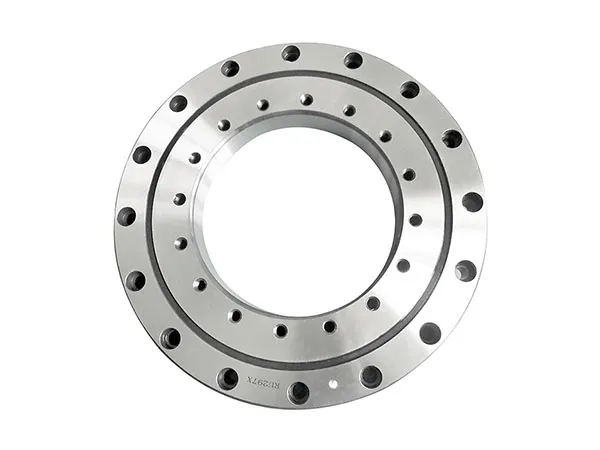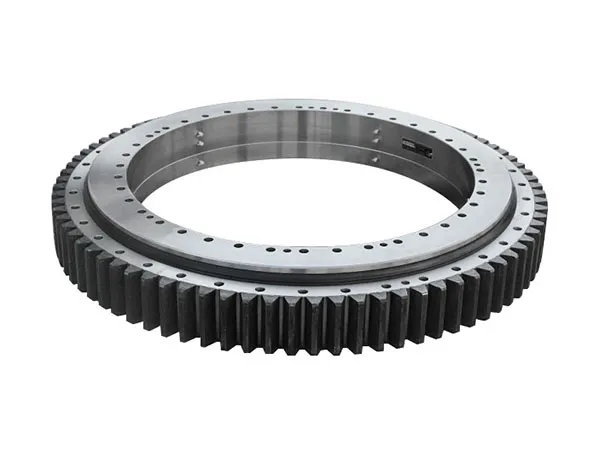- +86 13837949030 +86 15890619536
- info@lymcbearings.com export@lymcbearings.com
- Luoxin Industrial Cluster, Luoyang City,Henan Province,China
Time:2025-05-21 07:43:28 Source:LYMC Slewing Bearing
Slewing bearings, also known as slewing rings, are crucial mechanical components used to support axial, radial, and tilting moment loads in various heavy-duty machines, such as cranes, excavators, wind turbines, and rotating platforms. One of the most critical and common failures in slewing bearings is broken or damaged teeth on the gear ring.
Broken teeth on a slewing bearing can lead to serious operational issues, including abnormal noise, vibration, reduced load capacity, and eventually, total equipment failure. This kind of damage is often a result of improper installation, overloading, poor lubrication, or misalignment during operation.

Overloading:
Static Overload: Applying a load greater than the bearing's rated static capacity, even momentarily, can fracture teeth.
Dynamic Overload/Shock Loads: Sudden impacts, jerky movements, or unexpected high loads during operation (e.g., a crane hitting an obstruction) can exceed the tooth strength.
Uneven Load Distribution: If the mounting structure is not flat or rigid enough, or if bolts are unevenly torqued, the load can concentrate on a few teeth, leading to overload and fracture.
Poor Lubrication:
Insufficient Lubrication: Lack of lubricant increases friction and heat, leading to accelerated wear (pitting, scuffing) which weakens the teeth and can eventually cause them to break.
Incorrect Lubricant: Using a lubricant with the wrong viscosity, insufficient extreme pressure (EP) additives, or incompatibility with operating conditions can fail to protect the gear teeth.
Contaminated Lubricant: Dirt, debris, water, or metal particles in the lubricant act as abrasives, grinding away tooth material and creating stress risers.
Misalignment:
Improper Installation: If the slewing bearing is not mounted perfectly parallel and concentric with the driving pinion, the load will not be distributed evenly across the face width of the teeth. This leads to edge loading and high stress concentrations, causing tooth breakage.
Structural Deformation: Flexing or deformation of the supporting structures under load can also cause misalignment.
Fatigue Failure:
Repeated cyclic loading, even below the ultimate strength of the material, can lead to the initiation and propagation of cracks, eventually resulting in tooth fracture.
This is common in bearings that have been in service for a long time or have experienced many load cycles.
Material Defects or Manufacturing Flaws:
Inclusions, voids, or improper heat treatment (e.g., incorrect hardness or case depth of the gear teeth) during manufacturing can create weak spots that are prone to fracture under normal operating loads.
Foreign Object Intrusion:
Hard objects (e.g., stones, metal fragments, tools) getting trapped between the gear teeth of the slewing ring and the pinion can cause immediate tooth breakage.
Improper Gear Mesh/Backlash:
Too Little Backlash: Can cause binding, excessive heat, and high stresses on the teeth.
Too Much Backlash: Can lead to impact loading when the direction of rotation is reversed or when loads fluctuate, hammering the teeth.
Corrosion:
Exposure to corrosive environments without adequate protection can weaken the tooth material over time, making it more susceptible to fracture.

Proper Selection and Design:
Ensure the slewing bearing is correctly sized and specified for the application's loads, speeds, and duty cycle. Consider potential shock loads.
Consult with bearing manufacturers for assistance.
Correct Installation and Alignment:
Follow manufacturer's installation procedures meticulously.
Ensure mounting surfaces are flat, rigid, and clean.Use correct bolt grades and torque them evenly in the recommended sequence.
Verify proper alignment between the slewing ring gear and the drive pinion. Check and adjust backlash according to specifications.
Adequate and Regular Lubrication:
Use the lubricant type, grade, and quantity recommended by the bearing manufacturer.
Establish and follow a regular re-lubrication schedule.
Ensure the entire gear path is lubricated.
For grease-lubricated gears, purge old grease to remove contaminants.
Effective Sealing and Contamination Control:
Ensure seals are in good condition and properly installed to prevent ingress of dirt, water, and other contaminants.
Inspect seals regularly and replace if damaged.
Maintain a clean working environment around the equipment.
Regular Inspection and Monitoring:
Periodically inspect gear teeth for signs of wear (pitting, spalling, scuffing), cracks, or damage.
Listen for unusual noises (grinding, clicking) during operation.
Monitor for vibrations.
Check lubricant condition and analyze for wear particles.
Inspect bolt torque periodically.
Adherence to Operational Limits:
Operate the equipment within its designed load and speed limits.
Train operators to avoid shock loads and abrupt movements.
Implement overload protection systems if possible.
Operator Training:
Educate operators on proper operating procedures, load limits, and the importance of smooth operation to minimize stress on the slewing bearing.
Quality Sourcing:
Purchase slewing bearings from reputable manufacturers with good quality control processes to minimize the risk of material defects.
By implementing these preventive measures, the likelihood of experiencing broken teeth in slewing bearings can be significantly reduced, leading to increased equipment reliability and longevity.